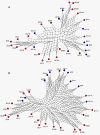Of woods and webs: possible alternatives to the tree of life for studying genomic fluidity in E. coli
- PMID: 21774799
- PMCID: PMC3160433
- DOI: 10.1186/1745-6150-6-39
Of woods and webs: possible alternatives to the tree of life for studying genomic fluidity in E. coli
Abstract
Background: We introduce several forest-based and network-based methods for exploring microbial evolution, and apply them to the study of thousands of genes from 30 strains of E. coli. This case study illustrates how additional analyses could offer fast heuristic alternatives to standard tree of life (TOL) approaches.
Results: We use gene networks to identify genes with atypical modes of evolution, and genome networks to characterize the evolution of genetic partnerships between E. coli and mobile genetic elements. We develop a novel polychromatic quartet method to capture patterns of recombination within E. coli, to update the clanistic toolkit, and to search for the impact of lateral gene transfer and of pathogenicity on gene evolution in two large forests of trees bearing E. coli. We unravel high rates of lateral gene transfer involving E. coli (about 40% of the trees under study), and show that both core genes and shell genes of E. coli are affected by non-tree-like evolutionary processes. We show that pathogenic lifestyle impacted the structure of 30% of the gene trees, and that pathogenic strains are more likely to transfer genes with one another than with non-pathogenic strains. In addition, we propose five groups of genes as candidate mobile modules of pathogenicity. We also present strong evidence for recent lateral gene transfer between E. coli and mobile genetic elements.
Conclusions: Depending on which evolutionary questions biologists want to address (i.e. the identification of modules, genetic partnerships, recombination, lateral gene transfer, or genes with atypical evolutionary modes, etc.), forest-based and network-based methods are preferable to the reconstruction of a single tree, because they provide insights and produce hypotheses about the dynamics of genome evolution, rather than the relative branching order of species and lineages. Such a methodological pluralism - the use of woods and webs - is to be encouraged to analyse the evolutionary processes at play in microbial evolution.This manuscript was reviewed by: Ford Doolittle, Tal Pupko, Richard Burian, James McInerney, Didier Raoult, and Yan Boucher.
Figures



Similar articles
-
Dichotomy in the evolution of pathogenicity island and bacteriophage encoded integrases from pathogenic Escherichia coli strains.Infect Genet Evol. 2011 Mar;11(2):423-36. doi: 10.1016/j.meegid.2010.12.003. Epub 2010 Dec 13. Infect Genet Evol. 2011. PMID: 21147268
-
Within-species lateral genetic transfer and the evolution of transcriptional regulation in Escherichia coli and Shigella.BMC Genomics. 2011 Oct 29;12:532. doi: 10.1186/1471-2164-12-532. BMC Genomics. 2011. PMID: 22035052 Free PMC article.
-
Genome dynamics and its impact on evolution of Escherichia coli.Med Microbiol Immunol. 2010 Aug;199(3):145-54. doi: 10.1007/s00430-010-0161-2. Epub 2010 May 6. Med Microbiol Immunol. 2010. PMID: 20445988 Review.
-
Structure and dynamics of the pan-genome of Streptococcus pneumoniae and closely related species.Genome Biol. 2010;11(10):R107. doi: 10.1186/gb-2010-11-10-r107. Epub 2010 Oct 29. Genome Biol. 2010. PMID: 21034474 Free PMC article.
-
Phylogenomic networks.Trends Microbiol. 2011 Oct;19(10):483-91. doi: 10.1016/j.tim.2011.07.001. Epub 2011 Aug 3. Trends Microbiol. 2011. PMID: 21820313 Review.
Cited by
-
Molecular musings in microbial ecology and evolution.Biol Direct. 2011 Nov 10;6:58. doi: 10.1186/1745-6150-6-58. Biol Direct. 2011. PMID: 22074255 Free PMC article. Review.
-
How microbiology helps define the rhizome of life.Front Cell Infect Microbiol. 2012 May 4;2:60. doi: 10.3389/fcimb.2012.00060. eCollection 2012. Front Cell Infect Microbiol. 2012. PMID: 22919651 Free PMC article. Review.
-
Bacterial genome instability.Microbiol Mol Biol Rev. 2014 Mar;78(1):1-39. doi: 10.1128/MMBR.00035-13. Microbiol Mol Biol Rev. 2014. PMID: 24600039 Free PMC article. Review.
-
Primal eukaryogenesis: on the communal nature of precellular States, ancestral to modern life.Life (Basel). 2012 Jan 23;2(1):170-212. doi: 10.3390/life2010170. Life (Basel). 2012. PMID: 25382122 Free PMC article.
-
Evolutionary analyses of non-genealogical bonds produced by introgressive descent.Proc Natl Acad Sci U S A. 2012 Nov 6;109(45):18266-72. doi: 10.1073/pnas.1206541109. Epub 2012 Oct 22. Proc Natl Acad Sci U S A. 2012. PMID: 23090996 Free PMC article.
References
Publication types
MeSH terms
Substances
LinkOut - more resources
Full Text Sources
Miscellaneous

